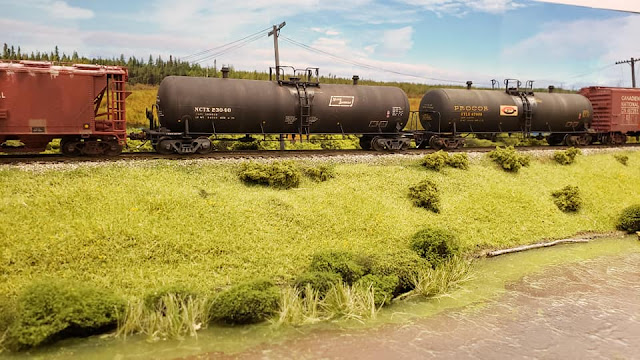CN B Unit Bounty
Previously I had worked on building a fleet of rebuilt CN F7 units <here>. A total of 3 units (2 F7Au and one F7Bu) were completed and I moved onto other projects. Recently I stumbled across another partly finished F7B and decided that I should get it wrapped up.
I bought this model as part of an ABA set of Kato drive Stewart F7 units from Dan Kirlin's hobby shop in Winnipeg circa 1994 (!?!). In previous decades I had added lift rings, a winterization hatch and had drilled out the various grab iron and railing mounting locations to the model. I used an OMI rooftop cooling coil for the coil seen on the prototype. These are long out of production and impossible to find now (made out of unobtanium), but Precision Scale has a plastic cooling coil that replaces this one.
As well, I had modified the fuel tank skirting and fuel tank to reflect the prototype arrangement. I then let the model marinate in the box for years due to work, family and other commitments.
The early 1990's vintage B unit shell has held up well compared to current offerings, but one problem was the CN stripes. For whatever reason Stewart painted the stripes incorrectly and reversed the white stripes with the black sections on the car body. This error will cause issues with the locomotive numbers placement on these locomotives. There was however one prototype locomotive with this stripe arrangement: CN F7Bu 9194.
The CN Transcona paint shop reversed the white and black sections while painting the unit after the rebuild. In doing so it is a match for the Stewart factory paint. This gave me my prototype starting point without having to do a full repaint.
When I wrote the two part article in CN Lines (www.cnrha.ca) on the CN rebuilt F unit fleet, we were able to source many photos of these units in service, including several of CN 9194. In reviewing the photos I realized that additional changes were needed to accurately model this unit.
The most noticeable difference from the stock model was that the car body ends were black instead of the red-orange paint on the model. I masked off the sides and airbrushed the ends and roof with Vallejo Air black paint. It sprays very well and gives good coverage. The rear ladder was painted separately and mounted it after the paint was dried.
I added the locomotive number and class data on the designated front (F) of the unit. On one side the standard white road numbers and class data can be used. The stripe issue crops up on the other side as the locomotive number position is on top of the stripe.
On the prototype the answer was to use black lettering on the white stripe. Fortunately I sourced the correct black numbers from a Sean Steele decal set for CN locomotives. It did not include black lettering for the class designation so I omitted this until I can source this in a decal. I may have to make a custom decal set for this purpose sometime down the road.
As I did on my previous F7 units I used 0.018" hypodermic tubing mounted on 0.010" phosphor bronze wire for the door railings. The prototype units had a larger vertical portion mounted with smaller diameter railing. The tubing and wire combination replicates this well, and the added bonus of the tubing staying straight is a good thing. I used some 0.020" styrene strip to get the offset from the side of the body while gluing the railings in place.
Another thing that needed to be added to the model were additional rooftop grab irons on either side of the rear steam generator roof hatch. There were also short stantions for a long railing along either side of the radiator fan and dynamic brake hatches. While the railings were no longer present on 9194 in my era, the stantions were still there.
The rear grab iron lengths were guesstimated from photos and bent from 0.0125" phosphor bronze wire. These were glued in place using 0.040" spacers to get roughly the correct height. These grabs also had a middle support post that I added using a length of the same size wire glued in a mounting hole in the middle of the grab iron.
The stantions required a bit more thought. I finally found some etched Kaslo Shops stainless steel brackets on their M420 etchings. I could modify the brackets to represent the squat square roof stantions.
Again I guesstimated the overall spacings for the stantions and mounted them in drilled mounting holes along the edge of the roof fan hatch. I painted all the grabs and stantions with the same black paint I airbrushed on the ends.
I added the remaining grab irons on the ends as well as uncoupling levers and air and trainline hoses. One initial weathering item that I did on this unit was add some oil grime around the roller bearing journals. Looking at prototype photos many of these units had leaky bearings as the roller bearing covers are obviously covered in oily grime. I did this using Vallejo Engine Effects 73.813 Oil Stains applied to the bearings as well as some areas adjacent to them. This gives an oily grimy appearance when dry.
The locomotive still needs a flat clear coat and some weathering but I now have another period correct locomotive with a unique paint scheme. I'll add more photos of the weathered unit when I get it finished.












Comments
Post a Comment